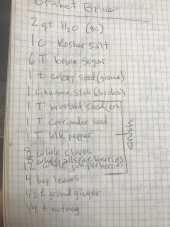Annie Hope wrote:
Also, am I right in presuming that you couldn't put a brisket smoker at the end of a rocket stove as it burns so hot there would be little flavour in the smoke?
I would humbly suggest that you are incorrect. I have not built mine (yet), but will be going with a vertical chamber smoker over a rocket stove firebox. I am a native Texan, so familiar with the style of pit you are referring. They are common but the design is not inherently better than a vertical chamber. There is much debate over cross draft vs direct draft configurations on the internet. There is a lot of time spent on balancing heat due to the horizontal orientation of these types of smokers. Since heat rises vertical chambers have the advantage of a good solid draw of smoke through the entire chamber naturally. Why people fight physics is a mystery.
Don't confuse a vertical smoker with a rocket heater design with the big chamber acting as a 'reburner' for the gasses released as smoke. In a rocket heater the gases are trapped in the barrel and burn completely and have more time to transfer the heat energy to the walls of the barrel. The up, down, up and out the flue design at very high temps, allows all the smoke to be converted completely to heat. Very efficient heater; but also very different from a rocket stove. In a rocket stove, the design does not have a reburn chamber. It burns fuel efficiently without a lot of smoke because of the efficient draft design. However, with both, the intake can be dampened to slow the air flow and slow the burn. By controlling the air, you will control the temp and the amount of un-burned gasses very efficiently.
Rocket stoves do burn hot. Or another way to look at it, is they burn to the same temperature, with less fuel. Use the efficiency of the design to your advantage. One does not have to burn half a cord of wood to develop a coal bed to then transfer the heat laterally and back through the cooking surface (cross draft). Very inefficient. A smoker has to come up to temp before the meat can be added regardless of the design, unless you have days to cook which is impractical in a commercial operation. Use the rocket stove concept to heat the metal and bring it to temp. Then use a very little bit of wood, with the flue shut down, allow the wood to smolder (providing the smoke) and to maintain temp.
It sounds as if you have done a lot of research, but since this may be read by others at a later date, let me add a few things. Meat stops building the smoke ring, or outer layer of meat that carries the smoke flavor, at 170F. Above this temp all the smoke does it toughen the 'bark' or outer layer of meat and gives it the texture and taste of a hockey puck. There is a time when 'low and slow' on the heat is good. But understand that the value added on the smoke flavor stops when the surface temp of the meat exceeds 170F. This is why it is recommended that the cooking temperature of the system stays around 225 and no higher than 250F. Having the oven in this range allows delta between the meat surface and the stove to change slower and build the smoke ring which is what it is all about.
All this can be summed up by this. The rocket stove design is very efficient at bringing the smoker up to cooking temp, and can be dampened easily and controlled with only the smoking wood, without the large bed of coals in an offset firebox. Also the design lends itself to good smoke dispersal and coverage in the vertical orientation. Unless you design the smoke chamber like a reburner, or get the heat up very hot, your smoke will stay smoke and not burn as fuel in the smoker. If your smoker chamber is that hot (500+F) the smoke will burn; but your meat is already ruined anyway at that high a temp.










